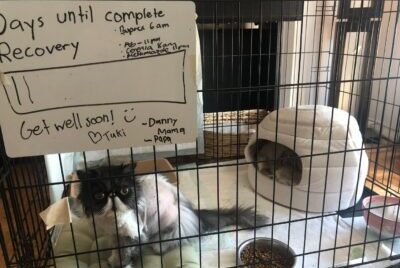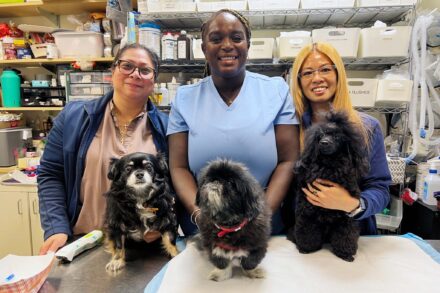How to Care for Your Cat After Surgery

How to Care for Your Cat After Surgery
June is Adopt a Shelter Cat month. Every year to celebrate, I devote my blogposts in the month of June to our furry, feline friends. June was chosen as Adopt a Shelter Cat month in part because kitten season is near its peak and there are many kittens available for adoption in the summer and early fall. Today’s blogpost will focus on the post-operative care of your cat.
While no one wants their cat hospitalized, many cats will spend a night away from home after spaying surgery, removal of a skin mass or other surgical procedures. While your cat is at the hospital, you might want to do some planning so you can be your cat’s best nurse.
Cage Rest for Your Post-Operative Cat
Following surgery, most cats are placed on cage rest. This takes advanced planning because your cat’s carrier is not large enough to hold food, water, a litter box and a bed. I suggest you identify a friend or family member with a large dog and ask to borrow their pen or crate for the duration of the cage rest prescription. The photograph accompanying this blogpost is a well-loved AMC feline patient on cage rest, recovering from surgery to remove a lung tumor.
Protect the Surgical Incision
Possibly the most important function of the feline nurse is to find a way to protect the surgical incision from the sharp barbs on a cat’s tongue. A persistent cat can undo a beautifully stitched incision in no time. The traditional method of protecting an incision is the Elizabethan collar. Cats and owners are not fond of this contraption, but it works well. These days, there are cuter versions like this lion recovery collar. If you are buying one of these, check with your veterinarian about the size to order.
An alternative to the cone is a surgical recovery suit. This product will work for some, but not all incisions. The surgical recovery suit protects the body, but not the limbs. If this is the product for your cat, be sure to order the right size well in advance and try it on before the surgery.
Monitor the Incision
The post-operative instructions from the veterinary surgeon typically ask owners to monitor the incision for swelling, redness or discharge. I suggest you take photos of the incision daily. The series of photos can easily be sent to your veterinarian if you are concerned about the incision, and the photos help you remember what it looked like yesterday.
Medications: Storage and Schedule
In the excitement of bringing your cat home from the hospital, don’t forget to check the directions on the medications dispensed by your veterinarian. Some may need to be refrigerated and will spoil if left sitting out on the counter while you tend to your cat. Medication regimens can be complicated. Liquid medication bottles may contain more doses than your cat needs. To help you stay on schedule, I suggest you make a medication chart to keep track of the drugs, number of doses per day and number of days of medication required. Here is an example of what I am describing.
| Amoxidrops | Cerenia | Mirataz | |
| 1 ml twice daily | ½ 16 mg tablet once daily | Apply 1.5 inches of ointment to the right ear once daily | |
| Morning | X | X | |
| Evening | X | X |
I hope these suggestions will help families provide the best nursing care possible to their favorite feline.
































